
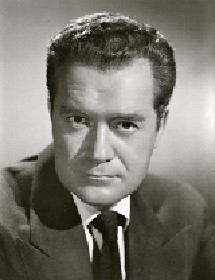 Night Beat (1950-52) aired “Long Live the Clown” on May 8, 1952 as its 93rd episode out of approximately 118 (depending on how one counts). Some 80 episodes are estimated to remain in circulation. This radio noir “detective” show featured film–-and later TV–-star Frank Lovejoy (1912-1962) as Randy Stone, the night beat reporter for the fictional Chicago Star newspaper.
Night Beat (1950-52) aired “Long Live the Clown” on May 8, 1952 as its 93rd episode out of approximately 118 (depending on how one counts). Some 80 episodes are estimated to remain in circulation. This radio noir “detective” show featured film–-and later TV–-star Frank Lovejoy (1912-1962) as Randy Stone, the night beat reporter for the fictional Chicago Star newspaper.
This is only the seventh episode of Night Beat we have showcased, the first being “The Devil’s Bible” from July of 2013, and the last being “The Bug Killings” from September of 2021. So a bit of background on the show is in order for newcomers. While well received, it ran for a modest two years before being cancelled, but not from any fault of its own. It had two factors going against it, both with origins at NBC. The time for a new radio show, and for a network to pour money into it, wasn’t the best. The early 1950s was becoming a growth spurt for the relatively new medium of television, and advertisers realizing its much larger potential audience were diverting their ad dollars away from radio and into this promising new market. Secondly, and for whatever reason, NBC around this time had a reputation for not supporting many of its shows with in-house advertising around the country, or allowing them the benefit of stable time slots so audiences could plan on listening to their favorite shows at a regular time. Both of these factors had a role in Night Beat‘s short life span. NBC would move it from one day of the week to another and at a different nightly time slot, without notice or fanfare, making it difficult for its audience to follow. Thus, while the show was a success, it was in spite of NBC, not because of anything its parent network did to support it.
As noted above, Frank Lovejoy portrayed Randy Stone, the night beat reporter for the fictional newspaper, the Chicago Star. He wasn’t the show’s first choice, however. Noted film actor Edmond O’Brien played Stone in an audition episode, but the censorship watchdogs that had for a long time been active in radio felt O’Brien’s hardcore, gritty characterization of Stone to be too stark for younger listeners, so decreed that Night Beat would have to air in a later time slot (after 9:30 PM) if it was to be given a green light. Rather than moving their new show in the making to a late night venue (with fewer listeners and thus fewer potential ad dollars spent), they would soften the Stone character. Enter Frank Lovejoy, with a voice historians would later place in the top ten of the most distinctive voices in radio. Lovejoy also brought his own sense of down to earth humanity and heartfelt compassion to the role (which he did to all of his radio roles, some 3,000 productions during his radio career), and Night Beat had its winning formula.
Lovejoy was a well known and respected film actor in the 1940s and 50s, having supporting or major roles in more than two dozen films, a scant few of many worth mentioning being 1949’s In a Lonely Place (starring Humphrey Bogart), and the title role in the classic 1951 noir crime thriller I Was a Communist for the FBI. Lovejoy featured prominently in several world War II and/or Korean War films, the most high profile probably his co-starring role with James Stewart in 1954’s Strategic Air Command. Of interest to SF genre fans is Lovejoy’s role as Lt. Tom Brennan opposite Vincent Price in the 1953 3D horror flick House of Wax (the first color 3D film to be released by a major American studio, and the first in a regular theater setting to offer stereophonic sound).
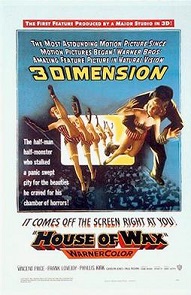
“Long Live the Clown” involves a hard-nosed Chicago gang of the mob variety trying to protect its territory, a communist spy, and as the title would indicate, a clown. If this seems like an odd mix, it is. It all begins when a woman approaches Randy looking for a newspaperman who will buy her story. Her tale begins with the admission that her husband is a communist spy. So why doesn’t she bring her story to the FBI instead of a newspaper, Randy asks her? And why is she giving up her husband as a spy in the first place? It turns out to be one of the more bizarre, not to mention dangerous stories Randy Stone has found himself in the middle of, as he does his job on the anything-but-routine night beat for the Chicago Star.
Play Time: 29:17
{This episode of Night Beat aired on a Thursday evening in April of 1952. The next afternoon after school the neighborhood gang met at the corner newsstand to stock up on some of their favorite magazines for the weekend. Famous Fantastic Mysteries (1939-53) specialized in reprints of classic SF and Fantasy stories, the issue below bringing to a new generation of readers British mystery and thriller author Austin J. Small’s 1926 novel about germ warfare The Death Makers, and J. S. Fletcher’s 1913 short story “The New Sun.” Famous Fantastic Mysteries was a bi-monthly in 1952. Other Worlds Science Stories (1949-53) was founded by Raymond A. Palmer as a fictional companion to his non-fiction magazine Fate, which specialized in the UFO phenomenon. The issue below ran Part I of a 3-part serial, 2 novelettes (one by J. T. McIntosh), and counting editor Palmer’s editorial no fewer than 7 (!) essays, some uncredited. From its first issue in November of 1949 until this issue near the end of its run, the magazine never held to a regular schedule, though it did manage 9 issues in 1952, the most it would ever see in any given year. Thrilling Wonder Stories (1936-55) was a favorite of long time science fiction fans, its stories full of the Sense of Wonder eagerly sought by readers of imaginative fiction. Many of its colorful, plot-driven, adventure stories on other worlds by beloved (now famous) authors have since become classics, often reprinted in many a collection to be found in huckster rooms at SF conventions. The issue below promised to be a good one, with a novella by Fletcher Pratt, novelettes by Joel Townsley Rogers (never heard of him), George O. Smith, and William F. Temple, and short stories by Richard Matheson, D. S. Halacy, Jr. (never heard of him), and Anthony Boucher. Rounding out the issue there were either letters of comment (locs) or articles by James Blish, Hal Clement, and Jerome Bixby, so all in all this issue sported a stellar lineup. TWS was a bi-monthly in 1952.}
[Left: Famous Fantastic Mysteries, 4/52 – Center: Other Worlds, 4/52 – Right: TWS, 4/52]
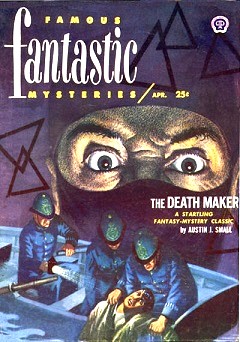
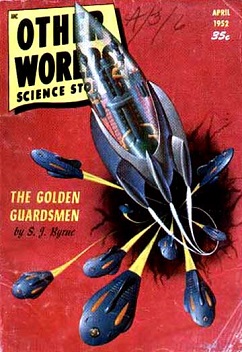
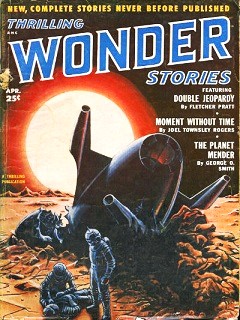
To view the entire list of weekly Old Time Radio episodes at Tangent Online, click here.